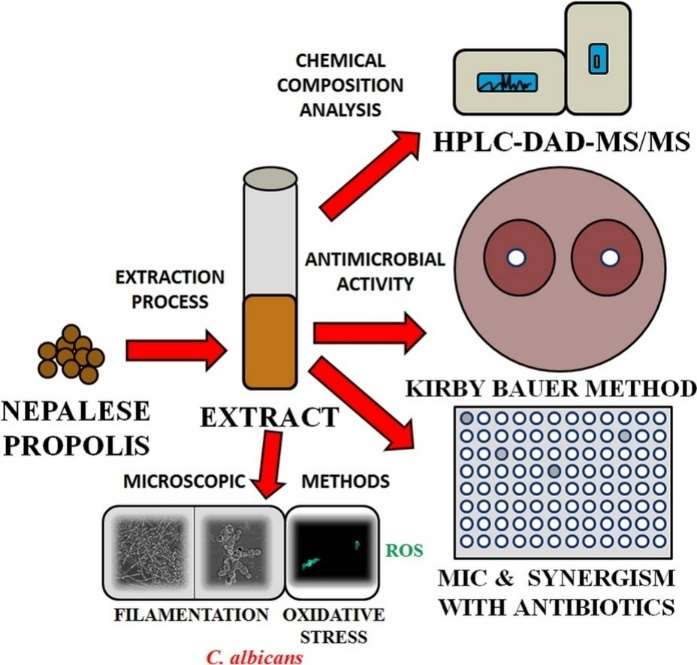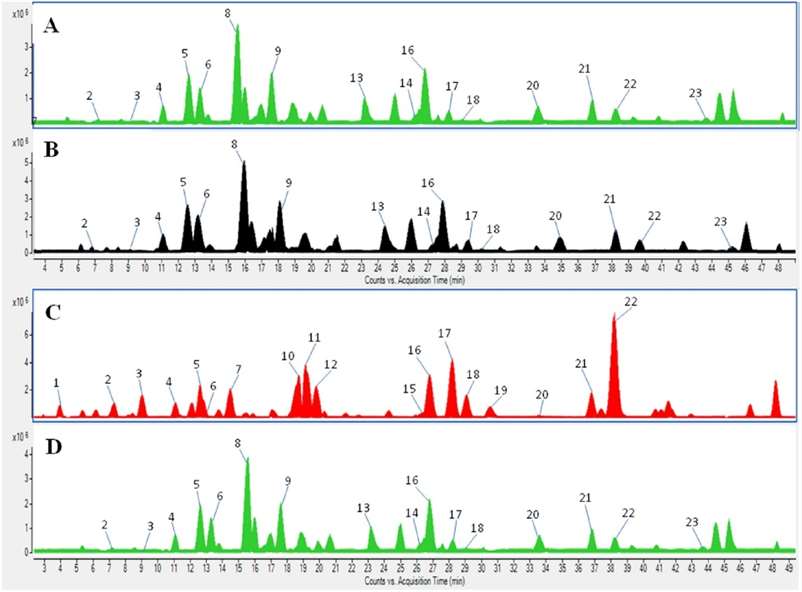What are Neoflavonoids and Why Analyze Them?
Neoflavonoids—unique and highly potent subclass of flavonoids—are among the essential components in nature that are offering pharmacological benefits. Primarily found in families, such as Fabaceae, they have captured the attention of researchers globally due to their potential as therapeutic agents. Neoflavonoids are known for having striking and diverse bioactivities that include antimicrobial, antioxidant, antitumor, and anti-inflammatory properties, among many others.
Unlike traditional flavonoids, Neoflavonoids are characterized by a structural rearrangement of the C ring in the flavonoid nucleus. This unique structural variation imparts them with diverse bioactive properties, making them efficacious in different health-related applications.
Neoflavonoids analysis involves the qualitative and quantitative investigation of different species of neoflavonoids in various specimens. Analyzing them can provide critical insights into optimally leveraging their potential benefits. Such an analysis contributes to a multitude of disciplines —from pharmacology and phytochemistry to food science and industrial applications.
For instance, it can aid in the development of novel therapeutic drugs or agents, culminate in the advancement of dietary supplements, help in monitoring and controlling their levels in the environment, and boost the quality control protocols of both pharmaceutical and natural product industries.
At Creative Proteomics, we provide reliable and accurate neoflavonoids analysis utilizing state-of-the-art analytical techniques and instruments.
Neoflavonoids Analysis at Creative Proteomics
Neoflavonoids Identification and Quantification
We provide accurate identification and quantification of various neoflavonoids in different samples such as plant extracts, biological fluids, and pharmaceutical formulations. This service can be beneficial in several aspects including, but not limited to, studying the impact of neoflavonoids on human health, determining the concentrations of these compounds in nutraceuticals, and exploring their influence on environmental health.
Comparative Analysis of Neoflavonoids
We conduct comparative analyses to understand the differences in concentration and presence of neoflavonoids in different plant varieties or samples prepared under varying conditions. Such analyses can offer insights into the effect of various factors such as environmental conditions, genetics, and post-harvest treatments on the production of neoflavonoids.
Metabolomic Profiling of Neoflavonoids
This service involves the comprehensive study of the metabolome, which constitutes all the metabolites, including the neoflavonoids, in a biological sample. It can offer significant insights into the functional state of a biological system.
Tracing the Metabolic Pathways of Neoflavonoids
We offer this service to explore the metabolic pathways of neoflavonoids in various organisms. It helps in understanding the biological roles of these compounds and their metabolites.
Neoflavonoids Analysis Techniques
Liquid Chromatography-Mass Spectrometry (LC-MS)
LC-MS is employed extensively because it can rapidly analyze a wide range of neoflavonoids with high sensitivity and selectivity. Creative Proteomics utilizes advanced LC-MS instruments for the analysis of neoflavonoids, including QTRAP LC-MS/MS and high-resolution LC-MS (Q Exactive).
- QTRAP LC-MS/MS: A hybrid triple quadrupole/linear ion trap mass spectrometer. It allows for simultaneous quantitative and qualitative analysis, achieving high-efficiency and high-sensitivity analyses.
- Q Exactive LC-MS: A high-resolution, accurate-mass (HRAM) system. It combines quadrupole precursor selection with high-resolution, accurate-mass (HRAM) Orbitrap detection, ideal for untargeted screening and quantitation of neoflavonoids.
Gas Chromatography-Mass Spectrometry (GC-MS)
Another technique often used in neoflavonoids analysis is GC-MS. Although it requires the derivatization of neoflavonoids, it provides good separation and quantitative results for volatile and thermally stable neoflavonoids.
Although the above mentioned are standard analytical techniques, specific neoflavonoids may need customized analytical methodologies. At Creative Proteomics, we offer method development services for challenging compounds or matrices.
 Workflow for Plant Metabolomics Service
Workflow for Plant Metabolomics Service
List of Neoflavonoids Analyzed (including but not limited to)
| Quercetin |
Kaempferol |
Myricetin |
Naringenin |
Isorhamnetin |
| Apigenin |
Kaempferide |
Rhamnazin |
Taxifolin |
Abyssinone |
| Amentoflavone |
Engeletin |
Eupatilin |
Isosophoraflavone |
Pterocarpan |
| 7,3'-Dimethoxyflavone |
7,4'-Dimethoxyflavone |
Sophoraflavone |
Pterocarpin |
Podocarpusflavone A |
| Sandwicensin |
Astilbin |
Trihydroxyflavone |
Pinocembrin |
4'-Methylflavone |
Sample Requirements for Neoflavonoids Assay
| Sample Type |
Sample Amount |
| Plant Extracts |
100 mg |
| Biological Fluids |
1 mL |
| Food Products |
50 g |
| Herbal Supplements |
2 g |
| Medicinal Plants |
100 mg |
| Tissue Samples (Animal/Plant) |
50 mg |
| Dietary Supplements |
2 g |
Deliverables of Neoflavonoids Analysis
- Details of sample preparation and analysis procedures
- List of identified Neoflavonoids with their retention times (Rt), mass-to-charge ratio (m/z), and relative quantification values
- Raw data files
- Interpretations and conclusions drawn from the analysis
Case. Antimicrobial Evaluation and Composition Analysis of Nepalese Propolis
Background:
Propolis, a natural resinous substance collected by bees, has gained attention for its potential antimicrobial properties. This study focuses on evaluating the antibacterial activity and chemical composition of Nepalese propolis, comparing it with other types, and exploring potential applications.
Sample:
The samples analyzed in this study include Nepalese propolis obtained from Apis mellifera L. (MEL) and Trigona sp. (TRI). The composition of these samples is examined using HPLC-DAD-MS/MS to identify various compounds.
Technical Platform and Procedure:
Antibacterial Screening: The antimicrobial properties were assessed using the disc-diffusion method against a range of bacteria and fungi. Strains included Staphylococcus aureus, Escherichia coli, Pseudomonas aeruginosa, Candida albicans, and more.
Influence on Antibiotic MIC: The impact of propolis extracts on the Minimum Inhibitory Concentration (MIC) of antibiotics against Staphylococcus strains was investigated.
Effect on C. albicans Filamentation: The influence of propolis on filamentation in Candida albicans was examined through incubation and microscopic analysis.
Oxidative Stress in C. albicans: The potential induction of oxidative stress by propolis extracts on C. albicans cells was studied using various markers and fluorescence microscopy.
Chemical Composition: High-Performance Liquid Chromatography with Diode Array Detection and Mass Spectrometry (HPLC-DAD-MS/MS) was employed to analyze the chemical composition of the propolis samples.

Results
Composition Analysis: The composition of MEL and TRI samples was found to be similar, resembling Brazilian red propolis and Dalbergia spp. resins. The presence of flavonoids, isoflavonoids, neoflavonoids, and other derivatives was identified.
Antimicrobial Properties: Nepalese propolis exhibited strong antimicrobial activity, especially against Helicobacter pylori and Staphylococcus aureus. The study suggests potential applications in the development of preparations against these bacteria.
Multidirectional Action: The propolis demonstrated multidirectional antimicrobial action, including the inhibition of C. albicans filamentation, generation of superoxide anion radicals (O2•−) and hydroxyl radicals (OH•), and a possible induction of oxidative stress.
Synergism with Antibiotics: The study revealed a confirmed synergistic effect of propolis with antibiotics, suggesting potential use in combination therapy.
 Comparison of HPLC-DAD-MS/MS analysis.
Comparison of HPLC-DAD-MS/MS analysis.
Reference
- Okińczyc, Piotr, et al. "Antimicrobial activity of Apis mellifera L. and Trigona sp. propolis from Nepal and its phytochemical analysis." Biomedicine & Pharmacotherapy 129 (2020): 110435.


 Workflow for Plant Metabolomics Service
Workflow for Plant Metabolomics Service
 Comparison of HPLC-DAD-MS/MS analysis.
Comparison of HPLC-DAD-MS/MS analysis.

